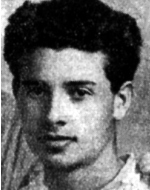Canaani, John
Son of Leah and Eliezer, members of the Tel Yosef farm, was born on July 15, 1925. He grew up and was educated in the Ein Harod-Tel Yosef joint school. Afterward, he studied for two years in a vocational school in Haifa. He returned to the farm and worked in metalwork, mainly in a metalwork and lathe shop. Yohanan Shaked brought out a perfect work. Perfected his own work methods and that of his assistants so that unnecessary materials and bodily movements would not be wasted unnecessarily. He devised plans to perfect the branches of the agriculture with the forces of the second generation, and he endeavored to instill them in the minds of the first generation. He took part in local public life and was elected to be one of two representatives of the second generation of the Culture Committee. When he was 15, he joined the Gadna and was sent to a squad commanders’ course. Returning to the farm after completing the course, he devoted his leisure time to guiding local youth and children and Youth Aliyah in sports. He was one of the best athletes of local Hapoel in various fields of athletics. He also participated in national competitions and participated in national and national defense competitions, where he managed to influence the urban youth sent during summer vacations to work in the agriculture, to make the most of his efforts to combat fatigue and momentary weakness. . During the Second World War, he wanted to volunteer for the Jewish Brigade, but the agriculture’s decision prevented him from doing so, because there was no one to fill his place in work and training. Yohanan devoted his professional work to the Haganah as well: he helped greatly in improving the weapons and maintaining his integrity. He was brought to the secret of the “hideouts” and there was considerable value for his activities. At the head of the youth movement he objected – until the order to withdraw – to the British entry into the agriculture on the “Black Sabbath” (29.6.1946), was stabbed in a dagger and later placed in detention in the Atlit and Rafah camps. When the War of Independence began, the agriculture could no longer hold it back, and even the order could not stop it from running into the most dangerous place. He participated in activities in the Gilboa region, the conquest of Parona, Ashrapia, Beit Shean, the explosion of bridges on the road to Jenin, and the establishment of the IDF in one of the battalions of the Golani Brigade. He was sent to an officers’ course and was sent to participate in the “Dani” operation. He was transferred to a battalion that operated in the mountains east of Latrun and later joined the Palmach’s Palmach battalion. In all his service places he excelled as a brave warrior But as a coach and commander of the kibbutzim, urban recruits and new immigrants alike, and as a good and devoted friend to his men, as part of Operation GIs to open the road to the Negev, his battalion was ordered to conquer Faluja. His company broke into the town, but due to lack of success in other areas of the operation and contact problems, it was ordered to withdraw. In this battle he fell, while covering his retreating men according to the order, on the 28th of Tammuz 5708 (28.7.1948). On the 13th of Adar II (21.3.1951) he was put to rest in the cemetery at Tel Yosef.
